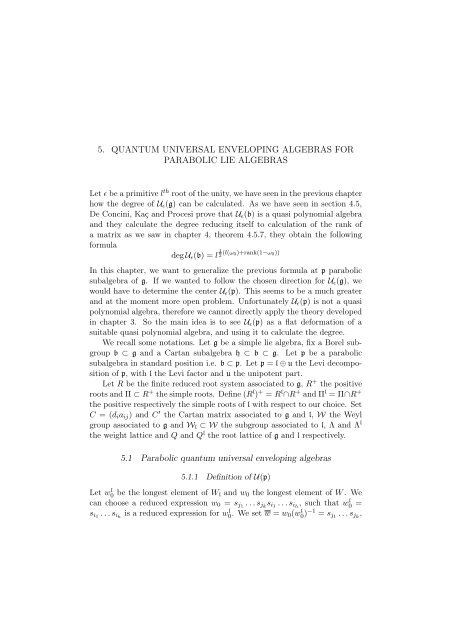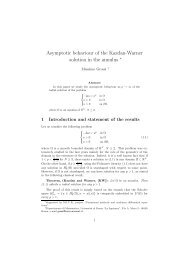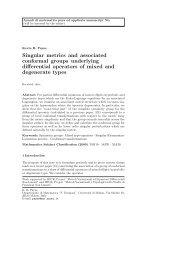Degree of Parabolic Quantum Groups - Dipartimento di Matematica ...
Degree of Parabolic Quantum Groups - Dipartimento di Matematica ...
Degree of Parabolic Quantum Groups - Dipartimento di Matematica ...
You also want an ePaper? Increase the reach of your titles
YUMPU automatically turns print PDFs into web optimized ePapers that Google loves.
5. QUANTUM UNIVERSAL ENVELOPING ALGEBRAS FOR<br />
PARABOLIC LIE ALGEBRAS<br />
Let ǫ be a primitive l th root <strong>of</strong> the unity, we have seen in the previous chapter<br />
how the degree <strong>of</strong> Uǫ(g) can be calculated. As we have seen in section 4.5,<br />
De Concini, Kaç and Procesi prove that Uǫ(b) is a quasi polynomial algebra<br />
and they calculate the degree reducing itself to calculation <strong>of</strong> the rank <strong>of</strong><br />
a matrix as we saw in chapter 4, theorem 4.5.7, they obtain the following<br />
formula<br />
deg Uǫ(b) = l 1<br />
2 (l(ω0)+rank(1−ω0))<br />
In this chapter, we want to generalize the previous formula at p parabolic<br />
subalgebra <strong>of</strong> g. If we wanted to follow the chosen <strong>di</strong>rection for Uǫ(g), we<br />
would have to determine the center Uǫ(p). This seems to be a much greater<br />
and at the moment more open problem. Unfortunately Uǫ(p) is not a quasi<br />
polynomial algebra, therefore we cannot <strong>di</strong>rectly apply the theory developed<br />
in chapter 3. So the main idea is to see Uǫ(p) as a flat deformation <strong>of</strong> a<br />
suitable quasi polynomial algebra, and using it to calculate the degree.<br />
We recall some notations. Let g be a simple lie algebra, fix a Borel subgroup<br />
b ⊂ g and a Cartan subalgebra h ⊂ b ⊂ g. Let p be a parabolic<br />
subalgebra in standard position i.e. b ⊂ p. Let p = l ⊕ u the Levi decomposition<br />
<strong>of</strong> p, with l the Levi factor and u the unipotent part.<br />
Let R be the finite reduced root system associated to g, R + the positive<br />
roots and Π ⊂ R + the simple roots. Define (R l ) + = R l ∩R + and Π l = Π∩R +<br />
the positive respectively the simple roots <strong>of</strong> l with respect to our choice. Set<br />
C = (<strong>di</strong>aij) and C ′ the Cartan matrix associated to g and l, W the Weyl<br />
group associated to g and Wl ⊂ W the subgroup associated to l, Λ and Λ l<br />
the weight lattice and Q and Q l the root lattice <strong>of</strong> g and l respectively.<br />
5.1 <strong>Parabolic</strong> quantum universal enveloping algebras<br />
5.1.1 Definition <strong>of</strong> U(p)<br />
Let w l 0 be the longest element <strong>of</strong> Wl and w0 the longest element <strong>of</strong> W. We<br />
can choose a reduced expression w0 = sj1 . . .sjk si1 . . .sih , such that wl 0 =<br />
. . .sjk ,<br />
si1 . . .sih is a reduced expression for wl 0 . We set w = w0(w l 0 )−1 = sj1








